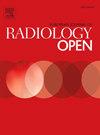Ultrasound-based radiomics and machine learning for enhanced diagnosis of knee osteoarthritis: Evaluation of diagnostic accuracy, sensitivity, specificity, and predictive value
IF 2.9
Q3 RADIOLOGY, NUCLEAR MEDICINE & MEDICAL IMAGING
引用次数: 0
Abstract
Purpose
To evaluate the usefulness of radiomics features extracted from ultrasonographic images in diagnosing and predicting the severity of knee osteoarthritis (OA).
Methods
In this single-center, prospective, observational study, radiomics features were extracted from standing radiographs and ultrasonographic images of knees of patients aged 40–85 years with primary medial OA and without OA. Analysis was conducted using LIFEx software (version 7.2.n), ANOVA, and LASSO regression. The diagnostic accuracy of three different models, including a statistical model incorporating background factors and machine learning models, was evaluated.
Results
Among 491 limbs analyzed, 318 were OA and 173 were non-OA cases. The mean age was 72.7 (±8.7) and 62.6 (±11.3) years in the OA and non-OA groups, respectively. The OA group included 81 (25.5 %) men and 237 (74.5 %) women, whereas the non-OA group included 73 men (42.2 %) and 100 (57.8 %) women. A statistical model using the cutoff value of MORPHOLOGICAL_SurfaceToVolumeRatio (IBSI:2PR5) achieved a specificity of 0.98 and sensitivity of 0.47. Machine learning diagnostic models (Model 2) demonstrated areas under the curve (AUCs) of 0.88 (discriminant analysis) and 0.87 (logistic regression), with sensitivities of 0.80 and 0.81 and specificities of 0.82 and 0.80, respectively. For severity prediction, the statistical model using MORPHOLOGICAL_SurfaceToVolumeRatio (IBSI:2PR5) showed sensitivity and specificity values of 0.78 and 0.86, respectively, whereas machine learning models achieved an AUC of 0.92, sensitivity of 0.81, and specificity of 0.85 for severity prediction.
Conclusion
The use of radiomics features in diagnosing knee OA shows potential as a supportive tool for enhancing clinicians' decision-making.
基于超声的放射组学和机器学习增强膝骨关节炎的诊断:诊断准确性、敏感性、特异性和预测价值的评估
目的评价超声图像放射组学特征在诊断和预测膝关节骨关节炎(OA)严重程度中的价值。方法在这项单中心、前瞻性、观察性研究中,从40-85岁原发性内侧骨关节炎和非骨关节炎患者的站立x线片和超声图像中提取放射组学特征。采用LIFEx软件(version 7.2.n)、方差分析和LASSO回归进行分析。评估了三种不同模型的诊断准确性,包括结合背景因素和机器学习模型的统计模型。结果491例肢体中OA 318例,非OA 173例。OA组和非OA组的平均年龄分别为72.7(±8.7)岁和62.6(±11.3)岁。OA组包括81名男性(25.5 %)和237名女性(74.5 %),而非OA组包括73名男性(42.2% %)和100名女性(57.8 %)。使用MORPHOLOGICAL_SurfaceToVolumeRatio (IBSI:2PR5)截断值的统计模型的特异性为0.98,敏感性为0.47。机器学习诊断模型(模型2)的曲线下面积(auc)分别为0.88(判别分析)和0.87(逻辑回归),敏感性分别为0.80和0.81,特异性分别为0.82和0.80。对于严重程度预测,使用MORPHOLOGICAL_SurfaceToVolumeRatio (IBSI:2PR5)的统计模型的灵敏度和特异性分别为0.78和0.86,而机器学习模型的严重程度预测的AUC为0.92,灵敏度为0.81,特异性为0.85。结论放射组学特征在膝关节OA诊断中的应用为临床医生的决策提供了一种支持工具。
本文章由计算机程序翻译,如有差异,请以英文原文为准。
求助全文
约1分钟内获得全文
求助全文
来源期刊

European Journal of Radiology Open
Medicine-Radiology, Nuclear Medicine and Imaging
CiteScore
4.10
自引率
5.00%
发文量
55
审稿时长
51 days
 求助内容:
求助内容: 应助结果提醒方式:
应助结果提醒方式:


